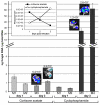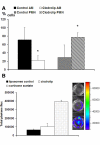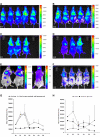In vivo bioluminescence imaging and histopathopathologic analysis reveal distinct roles for resident and recruited immune effector cells in defense against invasive aspergillosis
- PMID: 20377900
- PMCID: PMC2859869
- DOI: 10.1186/1471-2180-10-105
In vivo bioluminescence imaging and histopathopathologic analysis reveal distinct roles for resident and recruited immune effector cells in defense against invasive aspergillosis
Abstract
Background: Invasive aspergillosis (IA) is a major cause of infectious morbidity and mortality in immune compromised patients. Studies on the pathogenesis of IA have been limited by the difficulty to monitor disease progression in real-time. For real-time monitoring of the infection, we recently engineered a bioluminescent A. fumigatus strain.
Results: In this study, we demonstrate that bioluminescence imaging can track the progression of IA at different anatomic locations in a murine model of disease that recapitulates the natural route of infection. To define the temporal and functional requirements of distinct innate immune cellular subsets in host defense against respiratory A. fumigatus infection, we examined the development and progression of IA using bioluminescence imaging and histopathologic analysis in mice with four different types of pharmacologic or numeric defects in innate immune function that target resident and recruited phagocyte subsets. While bioluminescence imaging can track the progression and location of invasive disease in vivo, signals can be attenuated by severe inflammation and associated tissue hypoxia. However, especially under non-inflammatory conditions, such as cyclophosphamide treatment, an increasing bioluminescence signal reflects the increasing biomass of alive fungal cells.
Conclusions: Imaging studies allowed an in vivo correlation between the onset, peak, and kinetics of hyphal tissue invasion from the lung under conditions of functional or numeric inactivation of phagocytes and sheds light on the germination speed of conidia under the different immunosuppression regimens. Conditions of high inflammation -either mediated by neutrophil influx under corticosteroid treatment or by monocytes recruited during antibody-mediated depletion of neutrophils- were associated with rapid conidial germination and caused an early rise in bioluminescence post-infection. In contrast, 80% alveolar macrophage depletion failed to trigger a bioluminescent signal, consistent with the notion that neutrophil recruitment is essential for early host defense, while alveolar macrophage depletion can be functionally compensated.
Figures













Similar articles
-
Three-Dimensional Light Sheet Fluorescence Microscopy of Lungs To Dissect Local Host Immune-Aspergillus fumigatus Interactions.mBio. 2020 Feb 4;11(1):e02752-19. doi: 10.1128/mBio.02752-19. mBio. 2020. PMID: 32019790 Free PMC article.
-
Mitochondrial Reactive Oxygen Species Enhance Alveolar Macrophage Activity against Aspergillus fumigatus but Are Dispensable for Host Protection.mSphere. 2021 Jun 30;6(3):e0026021. doi: 10.1128/mSphere.00260-21. Epub 2021 Jun 2. mSphere. 2021. PMID: 34077261 Free PMC article.
-
Essential role for neutrophils but not alveolar macrophages at early time points following Aspergillus fumigatus infection.J Infect Dis. 2009 Aug 15;200(4):647-56. doi: 10.1086/600380. J Infect Dis. 2009. PMID: 19591573 Free PMC article.
-
Pulmonary defense mechanisms against opportunistic fungal pathogens.Immunol Ser. 1989;47:243-71. Immunol Ser. 1989. PMID: 2490078 Review.
-
Pathogenesis of Aspergillus fumigatus in Invasive Aspergillosis.Clin Microbiol Rev. 2009 Jul;22(3):447-65. doi: 10.1128/CMR.00055-08. Clin Microbiol Rev. 2009. PMID: 19597008 Free PMC article. Review.
Cited by
-
Reducing hypoxia and inflammation during invasive pulmonary aspergillosis by targeting the Interleukin-1 receptor.Sci Rep. 2016 May 24;6:26490. doi: 10.1038/srep26490. Sci Rep. 2016. PMID: 27215684 Free PMC article.
-
Novel Insights into Aspergillus fumigatus Pathogenesis and Host Response from State-of-the-Art Imaging of Host-Pathogen Interactions during Infection.J Fungi (Basel). 2022 Mar 4;8(3):264. doi: 10.3390/jof8030264. J Fungi (Basel). 2022. PMID: 35330266 Free PMC article. Review.
-
Infection-Mediated Priming of Phagocytes Protects against Lethal Secondary Aspergillus fumigatus Challenge.PLoS One. 2016 Apr 14;11(4):e0153829. doi: 10.1371/journal.pone.0153829. eCollection 2016. PLoS One. 2016. PMID: 27078879 Free PMC article.
-
Generation of A Mucor circinelloides Reporter Strain-A Promising New Tool to Study Antifungal Drug Efficacy and Mucormycosis.Genes (Basel). 2018 Dec 7;9(12):613. doi: 10.3390/genes9120613. Genes (Basel). 2018. PMID: 30544643 Free PMC article.
-
Monoclonal Antibodies and Invasive Aspergillosis: Diagnostic and Therapeutic Perspectives.Int J Mol Sci. 2022 May 16;23(10):5563. doi: 10.3390/ijms23105563. Int J Mol Sci. 2022. PMID: 35628374 Free PMC article. Review.
References
-
- Segal BH. Role of macrophages in host defense against aspergillosis and strategies for immune augmentation. Oncologist. 2007;12(Suppl 2):7–13. - PubMed
Publication types
MeSH terms
Substances
Grants and funding
LinkOut - more resources
Full Text Sources

